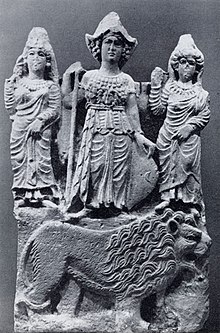| al-‘Uzzá | |
|---|---|
Goddess of might and protection | |
 | |
| Major cult center | Petra |
| Symbol | Three trees |
| Region | Arabia (Arabian Peninsula) |
| Genealogy | |
| Siblings | Al-Lat, Manāt |
| Part of the myth series on Religions of the ancient Near East |
| Pre-Islamic Arabian deities |
|---|
| Arabian deities of other Semitic origins |
Al-ʻUzzā (Arabic: العزى al-ʻUzzā [al ʕuzzaː] or Old Arabic, [al ʕuzzeː]) was one of the three chief goddesses of Arabian religion in pre-Islamic times and she was worshipped by the pre-Islamic Arabs along with al-Lāt and Manāt. A stone cube at Nakhla (near Mecca) was held sacred as part of her cult. She is mentioned in Qur'an 53:19 as being one of the goddesses who people worshipped.


Al-ʻUzzā, like Hubal, was called upon for protection by the pre-Islamic Quraysh. "In 624 at the 'battle called Uhud', the war cry of the Qurayshites was, "O people of Uzzā, people of Hubal!".[1] Al-‘Uzzá also later appears in Ibn Ishaq's account of the alleged Satanic Verses.[2]
The temple dedicated to al-ʻUzzā and the statue was destroyed by Khalid ibn al Walid in Nakhla in 630 AD.[3][4]
- ^ Tawil (1993).
- ^ Ibn Ishaq Sirat Rasul Allah, pp. 165–167.
- ^ S.R. Al-Mubarakpuri (6 October 2020). The sealed nectar. Independently Published. p. 256. ISBN 9798694145923. Retrieved 2013-02-03.
- ^ "He sent Khalid bin Al-Waleed in Ramadan 8 A.H", Witness-Pioneer.com Archived 2011-09-27 at the Wayback Machine